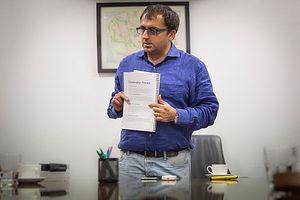New York City, with a history of just about 300 years, has more than 29,000 protected heritage buildings. India, on the other hand, has designated only about 15,000 structures under that category, despite being over 2,700 times bigger in size and its history dating back to more than 2,000 BC. What’s worse, dozens of these structures are not even traceable today due to urbanization and neglect. This can, and must, change, says Ratish Nanda, a conservation architect whose organization has saved several monuments in the country from disappearing.
There are at least three keys to conservation, Nanda, who heads the Indian chapter of the Aga Khan Trust for Culture, a Switzerland-based non-profit group, told The Diplomat in an interview in his office within the complex of one of Delhi’s most celebrated monuments, Humayun’s Tomb, a UNESCO World Heritage Site whose conservation his organization completed in 2013. Built in 1570, it was the first garden-tomb on the Indian subcontinent and inspired several major architectural innovations, culminating in the construction of the Taj Mahal. (For images of Humayun’s Tomb, and other sites restored by Nanda’s group, check out this recent photo essay).
“For conservation to succeed, the civil society and corporates must partner with the government. There is no other option,” said Nanda, who believes that people in India generally care little about their cultural heritage. This is evident in the fact that the Indian National Trust for Art and Cultural Heritage, a non-profit group to “make the citizens aware of the importance of their cultural and historical environment and help them to develop a harmonious relationship with it,” has only 7,000 members. Its British counterpart has 2 million members.
The Aga Khan Trust, which has been involved in the conservation of cultural heritage in India for more than 15 years through a unique private-public partnership, is seeking to change that. “We have partnerships with the government, local communities, donors and foreign embassies,” Nanda said.
The second key, Nanda added, is “conservation and development can and should go hand in hand.”
The biggest challenge in conservation is to win the trust of local communities so that they cooperate. Local resistance can be overcome by including their wellbeing in the conservation plan — for example, by building inclusive facilities for those living around heritage sites, Nanda explained. He added that his organization has built toilets and constructed and repaired sewage systems in and around the monuments under its project.
Three, conservation should involve “multi-disciplinary efforts,” he continued, indicating that the traditional engineering-archaeological approach won’t help much. “We have 30 different disciplines in the office. We have historians, architects, engineers, finance experts, designers, artists, planners, photographers, and so on,” he said.
“We are successful because of the lessons we have learnt in 30 countries,” Nanda added, referring to the work of the Aga Khan Trust, an agency of the Aga Khan Development Network, a family of institutions created by Aga Khan IV, the 49th and current Imam of Nizari Ismailism, a denomination of Shia Islam consisting of an estimated 25 million adherents around the world. France-based Aga Khan is one of the world’s 10 richest royals, according to Forbes magazine.
Some of India’s heritage sites are “gold mines,” Nanda said, and added that investing in conservation efforts can lead to huge economic gains.
“Conservation can fulfill many government objectives,” he said, citing revenue from tourism as one of them. “The number of visitors to Humayun’s Tomb has gone up by 1,000 percent after we completed the work, and we think it can further go up.”
Unemployment is a major concern for all governments, and conservation can help deal with it, at least to some extent, added Nanda. “Through conservation we have generated more than 500,000 man-days of work, so it’s employment creation,” he said, referring to the project to conserve Humayun’s Tomb.
The Aga Khan Trust has trained 2,700 youth in the project in various skills. Some of them are now heritage guides, Nanda said.
“We have also created women self-help groups, involving about 200 women who are making and selling handicraft items. These are women who had never earned even a penny in their lives earlier. And these are conservative women who are not allowed to work outside,” the architect said, referring to women living in Nizamuddin Basti, which is next to the Humayun’s Tomb and boasts the Nizamuddin Dargah, the mausoleum of the 13th century Sufi saint of Delhi, Hazrat Nizamuddin Auliya, who was much revered by the rulers of Delhi.
Conservation can also promote communal harmony, Nanda added.
India has witnessed numerous incidents of communal violence since the Partition of India and Pakistan during India’s independence from British rule in 1947.
Conservation leads to a better understanding of the other, Nanda explained. Those who are not Muslim enjoy qawwali, a form of Sufi devotional music, and love Muslim food, he said, giving an example. “Had it not been for these cultural sites, many wouldn’t want to come to Nizamuddin Basti at all, thinking it’s a Muslim area.”
Aga Khan’s Ismaili denomination is considered a heretical sect by some Muslim communities, but Nanda’s organization, which focuses on preserving Muslim heritage around the world, has managed to gain cooperation from diverse Muslim communities.
Monuments, if well preserved, can also instill pride in the people and the nation, he added.
Conservation, he stressed, means “bringing a building to its original state, whatever the original builder constructed, and the building should last for the next 10 generations and be in a better state [than] that we inherited it in.”

































